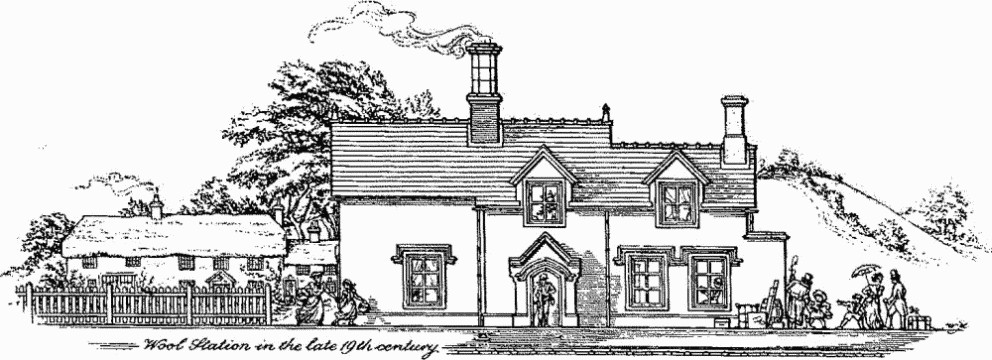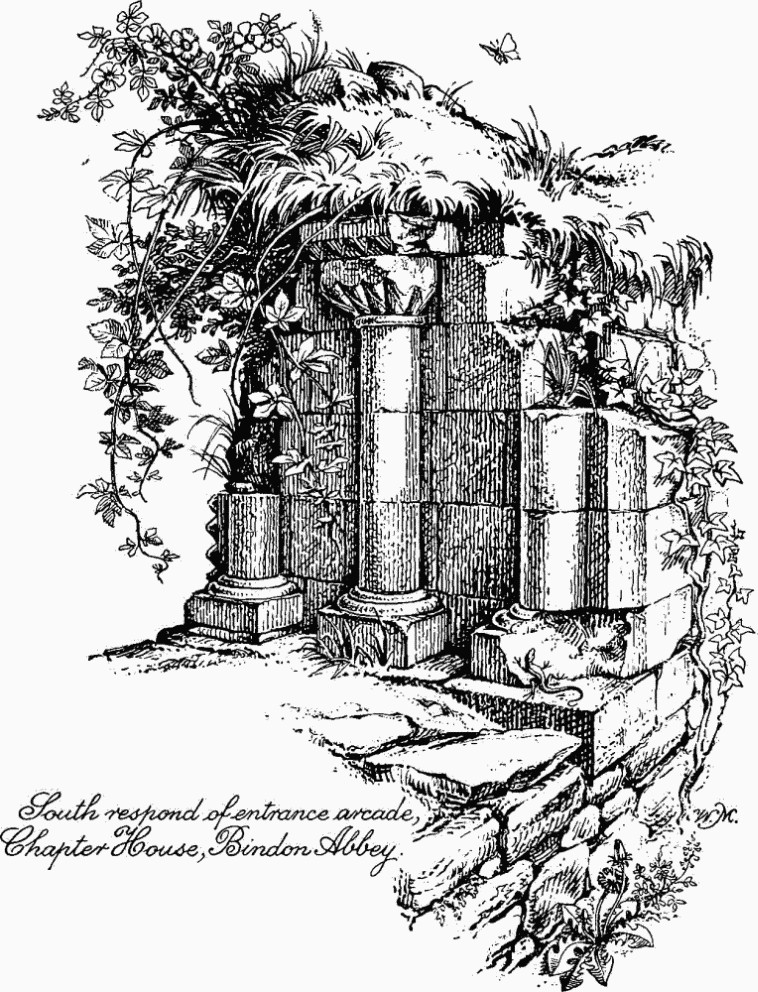An Inventory of the Historical Monuments in Dorset, Volume 2, South east. Originally published by Her Majesty's Stationery Office, London, 1970.
This free content was digitised by double rekeying. All rights reserved.
'Southampton and Dorchester Railway', in An Inventory of the Historical Monuments in Dorset, Volume 2, South east, (London, 1970) pp. 416-417. British History Online https://www.british-history.ac.uk/rchme/dorset/vol2/pp416-417 [accessed 26 April 2024]
SOUTHAMPTON and DORCHESTER RAILWAY
The London and South Western line from Southampton to Dorchester via Ringwood and Wimborne with a branch to Poole was authorised in 1845 (8/9 Vic. cap. xciii) and was opened in June 1847; Poole station was then at Hamworthy and reached by a branch line from Poole Junction, now called Hamworthy Junction. The constructional engineer was Capt. W. S. Moorsom (D.C.R.O., Deposited Plans). A station in Poole town was opened in 1872, being reached by a branch from the New Poole Junction at Broadstone. Poole was joined to Bournemouth by the line through Parkstone in 1874, but trains from Bournemouth to Dorchester had to reverse at Broadstone until the Holes Bay Curve was opened in 1893. A line from New Poole Junction to Blandford was opened in 1860.
The Yeovil to Weymouth section of the Wiltshire, Somerset and Weymouth Railway was opened in 1857 and the South Western line was joined to it at Dorchester by a short portion of mixed gauge track. The construction of the Weymouth line had been authorised in 1845 (8/9 Vic. cap liii) and the alignment amended the following year for the protection of Maumbury Rings. Earthworks were in progress at Poundbury (see Dorchester (172), Pt. 3, p. 487) in 1855, and on 26 November 1856 I. K. Brunel reported that the joint station at Weymouth was very nearly completed (P.R.O., M.T. Box 510 (MPR)).
A report on the Southampton-Dorchester line by Capt. Coddington dated 25 May 1847 (P.R.O., M.T. 6/4 No. 916) states that at Poole Junction, Wareham, Wool, Moreton and Dorchester Terminus the permanent buildings containing booking offices and waiting rooms were erected and covered in; most of them were completed. Seven bridges were entirely of masonry with brick arches, fifteen had brick piers or abutments and a superstructure of flat iron girders or timber, and there were eleven timber viaducts. The level crossings were very dangerous, but all the Public Turnpike Roads had proper gates and also lodges for the accommodation of the gatekeepers.
W. of Wimborne the original station houses remain, all enlarged and altered; a gatekeeper's cottage at Wool has been demolished; all the iron and timber bridges have been wholly or partly rebuilt, and none of the timber viaducts remains. Wareham station was rebuilt on a new site further W. in 1864.
Station Houses. With the exception of Dorchester Terminus each of the original stations has a two-storey house built in Jacobean style. Walls are of red or Broadmayne brick with yellow quoins (Wool now colour-washed) and the gabled roofs are covered with slates. Windows have plastered surrounds and moulded labels. A drawing of Wool station house was made in 1876, when a new waiting room was added (British Rail, S.R., Chief Engineer's Office); it shows the original accommodation on the ground floor to have comprised a booking office entered from the platform through a porch and having a second doorway leading directly into the living room; behind the latter was a staircase and a kitchen; behind the booking office were a small back kitchen, public conveniences and, projecting at the back, a W.C. and coal store. The old station house at Wareham remains, in derelict condition. The house at Poole Junction (Hamworthy Junction) is rather larger and has yellow brick dressings to the windows and no labels.
Dorchester station has a U-shaped building, also of red brick with yellow dressings, with projecting wings flanking the entrance; the ends of the wings are divided into three bays by stuccoed pilasters. Between the wings is a modern canopy; the interior has been entirely rearranged. The canopy over the platform is modern; originally a roof covered both the up and down platforms and the line between, but the down platform has been removed to a new site.
Waiting Sheds remain at Wool and Moreton stations which were erected probably soon after 1847. They are openfronted shelters with pent roofs carried at the front on timber arcades of seven elliptical arches.
Goods Sheds at Dorchester and Wareham are built of brick with large round-arched doorways and windows set in matching round-arched recesses; that at Dorchester has been enlarged.
Gatekeepers' Cottages at Upton (982931), Wareham (920881), Holmebridge (891869), East Stoke (872869), Bailey's Drove (837867), East Burton (831868), Moreton station (779890) and Woodsford Signals (752891) are of one storey with walls of red or Broadmayne brick with yellow dressings, some now colourwashed, and with slated hipped roofs. The last mentioned has a second storey added. On plan each comprises two rooms and an outshot along the back containing the entrance. The front towards the railway has two hung-sash windows with a small round-headed recess between them. The end towards the road has a shallow gabled projection containing a window. In the outshot are small round-headed windows grouped in pairs.
The two cottages at Wareham are of rather more elaborate design, each having two polygonal bays facing the railway line containing and flanking groups of small round-headed windows.
Bridges. The timber trestle bridge that carried the railway S. from Wimborne over the river Stour (018991) is illustrated in the Illustrated London News, June 5, 1847.
The Wimborne-Poole road crosses the railway cutting at 015981; the cutting is brick-lined and covered by arched ribs at intervals with arched filling between, all in brick except the end ribs which have iron voussoirs incorporated in the haunches of the arches.
Adjoining Broadstone station the roadway is carried over the line by a three-centred brick arch. A later semicircular arch adjoins it over the Bournemouth line.
At Worgret (986870), W. of Wareham, the Wool road crosses the railway, here in a cutting, on three brick skewed arches carried on rubble piers with brick dressings. The parapets, originally of white brick, have been mostly rebuilt.
On Winfrith Heath the road to Moreton crosses the railway cutting at 810877. The bridge is of three spans; rubble piers, originally pierced by brick arches now blocked, carry two original cast-iron I-section beams with integral stiffeners. Outside these are modern timber beams, and the decking is of timber.
S. of West Stafford at 727893 is a single-span bridge, the road being carried over the railway on modern girders spanning between brick and rubble abutments. Outside the modern girders two original cast-iron beams remain; the beams are of greater depth in the middle than at the ends, the upper flanges are smaller than the bottom ones and the beams are cast with five stiffeners each side.
W. of West Stafford at 718896 is a single-span bridge carrying the Dorchester road over a cutting. The roadway is carried on modern girders between rubble and brick abutments but to each side are original cast-iron railings with plain standards curved at the top to form intersecting arches; the railings stand on a boldly moulded iron plinth above cast-iron I-section beams to which are fixed plates moulded with the names and date W. & J. Lancester Southampton 1846.


South Respond of Entrance Arcade, Chapter House, Bindon Abbey
